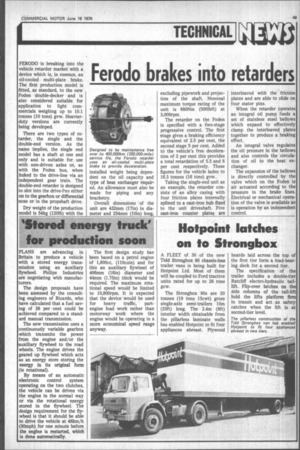Ferodo brakes into retarders
Page 51

If you've noticed an error in this article please click here to report it so we can fix it.
FERODO is breaking into the vehicle retarder market with a device which is, in essence, an oil-cooled multi-plate brake. The first production model is fitted, as standard, to the new Foden double-decker and is also considered suitable for application to light commercials weighing up to 10.1 tonnes (10 tons) gvw. Heavierduty versions are currently being developed.
There are two types of retarder, the single and the double-end version. As the name implies, the single end model has a shaft at one end only and is suitable for use with non-driven axles or, as with the Foden bus, when linked to the drive-line via an independent gear train. The double-end retarder is designed to slot into the drive-Pne either on to the gearbox or differential nose or in the propshaft drive.
Dry weight of the production model is 54kg (1201b) with the
Designed to be maintenance free over its 400,000km (250,000-mite) service life, the Ferodo retarder uses an oil-cooled multi-plate brake to provide deceleration.
installed weight being dependent on the oil capacity and type of heat exchanger required. An allowance must also be made for piping and any bracketry.
Overall dimensions • of the unit are 432mm (17in) in diameter and 254mm (10in) long, excluding pipework and projection of the shaft. Nominal maximum torque rating of the unit is 680Nm (5001bft) at 3,00Orpm.
The retarder on the Foden is specified with a two-stage progressive control. The first stage gives a braking efficiency equivalent of 2.5 per cent, the second stage 5 per cent. Added to the vehicle's free deceleration of 3 per cent this provides a total retardation of 5.5 and 8 per cent respectively. These figures for the vehicle laden to 16.3 tonnes (16 tons) gvw.
Taking the single-end unit as an example, the retarder consists of an alloy casing with four friction plates internally splined to a cast-iron hub fixed to the unit driveshaft. Five cast-iron counter plates are interleaved with the friction plates and are able to slide on four stator pins.
When the retarder operates an integral oil pump feeds a set of stainless steel bellows which expand to effectively clamp the interleaved plates together to produce a braking effect.
An integral valve regulates the oil pressure in the bellows and also controls the circulation of oil to the heat exchanger.
The expansion of the bellows is directly controlled by the valve which on the Foden is air actuated according to the pressure in the brake lines. Electrical or mechanical operation of the valve is available as is operation by an independent control.












































































































































































